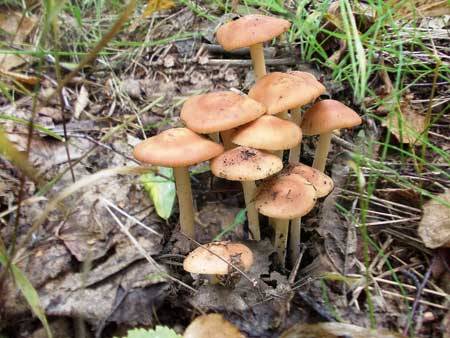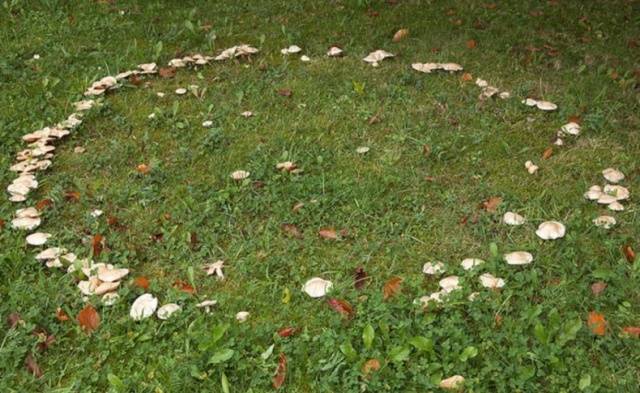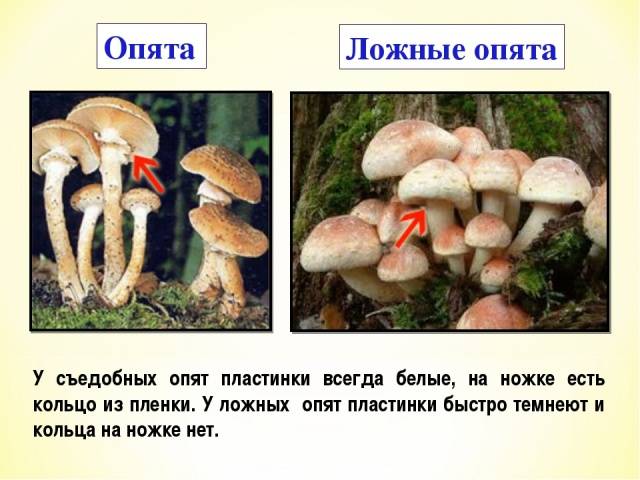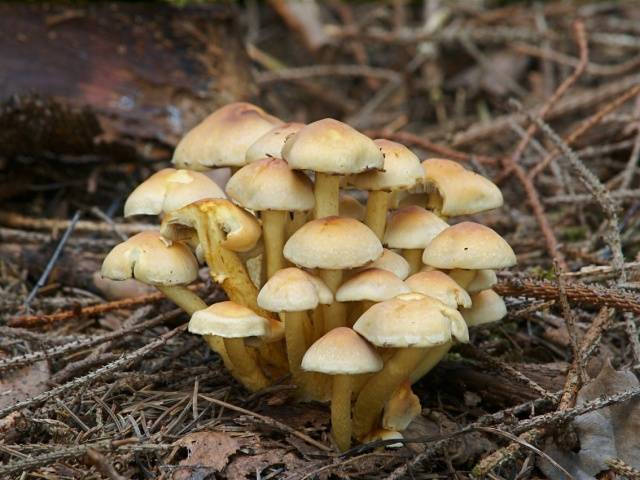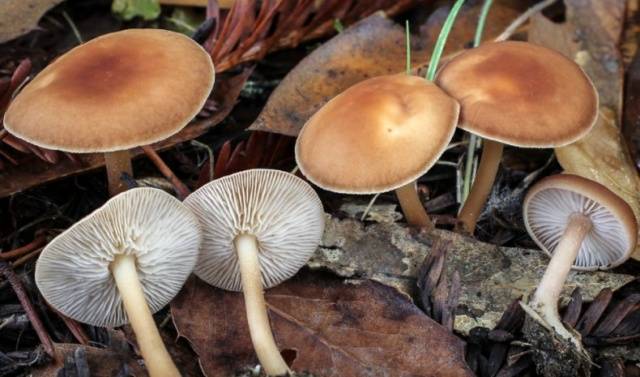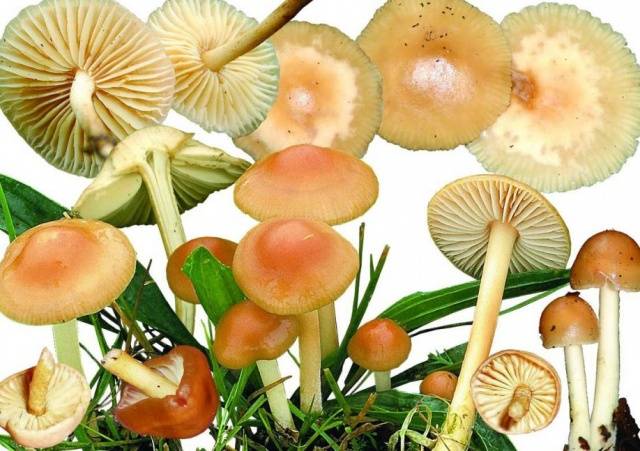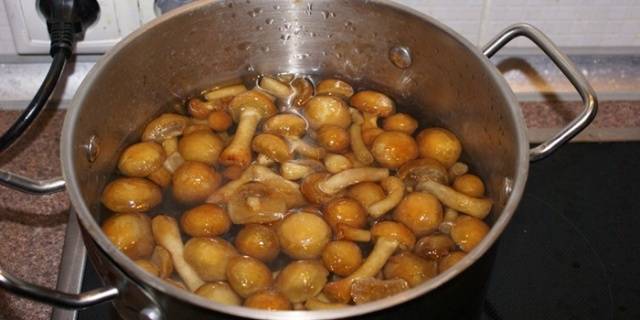Content
Edible meadow mushrooms are easily recognizable by a small hat with a diameter of up to 6 cm. In young mushrooms, it is slightly convex, but over time it becomes even with a small tubercle in the center. The hat of the edible meadow is also recognized by its light brown color and sticky surface when moisture gets on it. A characteristic feature is a short cylindrical leg with a small ring near the cap. All other similar mushrooms that do not fit the description are false mushrooms.
Where meadow mushrooms grow
Photo: what edible meadow mushrooms look like growing in a meadow
A feature of this type of mushroom is that they do not grow on a stump, but have chosen the soil for their place of residence. Habitat and reproduction of meadow honey agaric occurs in meadows. They can be found among dense grass in the forest, between groups of trees, in pastures, meadows, along garden paths. Meadows do not grow singly. Usually they create families, crawling out among the dense grass in rows. Sometimes in the clearing there is a ring with a diameter of about 80 cm. People call this phenomenon witch's circles.
When to collect meadow mushrooms
Photo: meadow mushrooms in the meadow
Meadow mushrooms grow in damp warm weather. Seasoned lovers of quiet hunting intuitively determine the time of collection. If the spring was accompanied by warm rains, in early June you can wander through the meadows. Under suitable weather conditions, meadows can emerge from the ground all summer and autumn before frost begins. In order not to miss the harvest, a novice mushroom picker should know that these mushrooms sprout en masse and die off quickly.
The video tells about meadows:
How to distinguish edible from inedible meadow honey
Explanatory photo: how to distinguish meadow mushrooms from false ones
The edible meadow mushroom is recognized by the following:
- Leg. The edible meadow has a ring in the upper part under the cap. The height of the leg is about 6 cm. An exception may be an old large mushroom. False fungus has a leg without a ringlet or has a thin growth. They always grow elongated. The length of the leg is 10 cm or more.
- Plates. If you look under the cap, then the edible mushroom has lamellar tissues dull yellow, sometimes cream in color. In the false young meadowman, they are bright yellow. When the cap begins to age, the color of the lamellar tissue changes from green to black.
- Hat. Regardless of where it grows, weather and environment, the top of the edible meadow's cap is dull brown with dark scales. In a false mushroom, the cap is always replete with bright colors with a predominance of a red tint, and there are no scales.Important! There can be an edible meadow without scales. They disappear when the fungus ages. Such a specimen can be recognized by its dark brown hat.
- Taste qualities.It is believed that all inedible mushrooms are bitter. It's a delusion. There are many poisonous mushrooms with normal taste. It is impossible to identify edible specimens on such grounds.
- Smell. If you pick an edible meadow, a pleasant mushroom aroma immediately emanates from it. False mushrooms smell like rotten soil or mold.
- Contact with water. Edible meadow grass does not change its color when soaked in water. False mushrooms turn black or dark blue.
Despite the large number of signs, it is difficult for a beginner to recognize which category a mushroom belongs to. Before using it, it is better to ask an experienced mushroom picker for advice.
False meadow mushrooms
Now it's time to take a closer look at the photo and description of false meadow agarics. This is necessary in order to learn how to recognize them better on the lawn and avoid them.
All inedible meadows have the following characteristics:
- long elongated leg without a ring at the cap;
- earthy smell;
- bright color of the cap with a predominance of a red tint;
- the plates are dark, sometimes black;
- poisonous mushrooms grow for a short time in spring and autumn, and they are not found in summer.
Some false meadow mushrooms taste good, but you shouldn't try them to recognize them.
Dangerous twins of meadow mushrooms
Considering photos of meadow mushrooms, it is not always possible in reality to determine which category the mushroom belongs to. This is due to the presence of twins.
Poisonous talker whitish
Outwardly, the mushroom is so beautiful that you want to put it in a basket. However, it is very poisonous. The talker is distinguished by its curved saucer-shaped hat and bright white color. The leg is short, the length does not exceed 4 cm. The whitish talker has two additional subspecies: waxy and grayish. A dangerous mushroom grows in the same places where meadows live.
Kollybia les-loving
This mushroom cannot be put in a basket if you know its habitat. For edible meadows they go to open meadows. Collibia loves to grow in mixed forests. The fungus takes nutrients from rotten wood, decaying foliage. Colibia is not found in open meadows. The twin can be recognized by a light leg about 6 cm long, a brown hat with a white tint and a strong unpleasant odor.
How to cook meadow mushrooms
It doesn't matter what recipe is supposed to cook meadow mushrooms, they are first cleaned. The harvest is very dirty after the rain. The sticky cap sticks to dirt, grass, gnats. If the meadows are harvested in dry weather, there will be fewer problems with cleaning.
First, the crop is sorted. All wormy and suspicious mushrooms are thrown away. Further cleaning depends on what is supposed to be done:
- If the meadows are going to dry, they cannot be soaked in water. Each mushroom is carefully wiped with a dry or slightly damp cloth, put on a baking sheet, and sent to the oven. Can be dried naturally under the sun by stringing them on a string.Important! If the mushrooms are soaked in water before drying, the heat treatment time will increase. In the oven, watery flesh can cook, and when dried naturally, it can rot.
- When it is supposed to cook or canned meadow mushrooms immediately after assembly, they are thoroughly washed. The water is changed at least 3 times. You can even soak the meadows for several hours to better wash out the sand from the plates. During wet cleaning, remove the leg rings. They impart a sour taste and distort the flavor.
When all the mushrooms are thoroughly cleaned, you can start cooking.
There are different recipes for cooking meadow mushrooms, ranging from the simplest frying to the masterpieces of culinary art. Foresters and experienced mushroom pickers claim that meadows can be eaten even raw. In theory, yes, but the dirty environment now does not allow doing this. For safety, it is better to boil the mushrooms.
Short-term heat treatment completely cleans the mushroom tissues from harmful accumulations from the polluted natural environment.
The simplest preparation consists of the following steps:
- meadows are cleaned;
- large specimens are cut into several parts;
- mushrooms in a saucepan are poured with water, put on a high fire;
- after boiling, reduce the heat and continue to cook for another 15 minutes;
- the cooked mushrooms are strained, poured with clean water and boiled again for 15 minutes.
After the time of the second cooking, the meadows are strained. Now honey mushrooms are considered actually ready to eat, but in this form they are not tasty. Mushrooms are used for further cooking, depending on the recipe.
The benefits of meadow mushrooms
Mushrooms are a source of protein, vegetable fats and carbohydrates, but they are low in calories. 100 g of pulp contains a maximum of 22 kcal. Additionally, there are mushroom antibiotics, copper and other beneficial substances. Scientists have not yet fully explored the full benefits of mushrooms. However, traditional medicine uses them to strengthen the body, treat tumors, reduce blood pressure, as a laxative. Honey mushrooms are useful for the heart, stomach and other organs, but they need to be eaten in moderation.
Any mushroom is considered difficult for the digestive system. If there are serious problems with the gastrointestinal tract, then it is better to refuse the use of delicious gifts of nature. It is worth limiting admission to the elderly and children under the age of 7 years. In all other cases, there are no contraindications for eating meadows.
A few secrets of how to avoid poisoning
The modern ecology is so polluted that even edible mushrooms can be poisoned. Often, trouble occurs due to mistakes made by the person himself when collecting or preparing honey agarics. To avoid poisoning, experienced mushroom pickers are advised to adhere to the following rules:
- If you didn't pick the mushrooms yourself, but bought them on the market, sort them carefully. Between mushrooms there may be poisonous doubles or pieces of them. All broken and suspicious meadows must be thrown away.
- Many meadows grow along roads and near factories. You cannot collect them. The porous tissue of the fungus absorbs all harmful substances.
- It is unacceptable to violate the honey agaric processing technology. Mushrooms must not be cooked in an aluminum pan or zinc-coated pan. If you are not sure about the ecological cleanliness of the area where the crop was harvested, it is better to soak the meadows for three days. It is advisable to change the water every three hours.
In case of mushroom poisoning, first aid is aimed at causing vomiting. Before this, the patient is given a plentiful drink. Call a doctor immediately, otherwise the consequences may be serious for the victim.
Conclusion
Meadow mushrooms are a tasty and healthy mushroom. However, it is more difficult to recognize than a traditional honey fungus growing on a tree stump. If you are unsure of your knowledge, it is better not to pick unfamiliar mushrooms.
